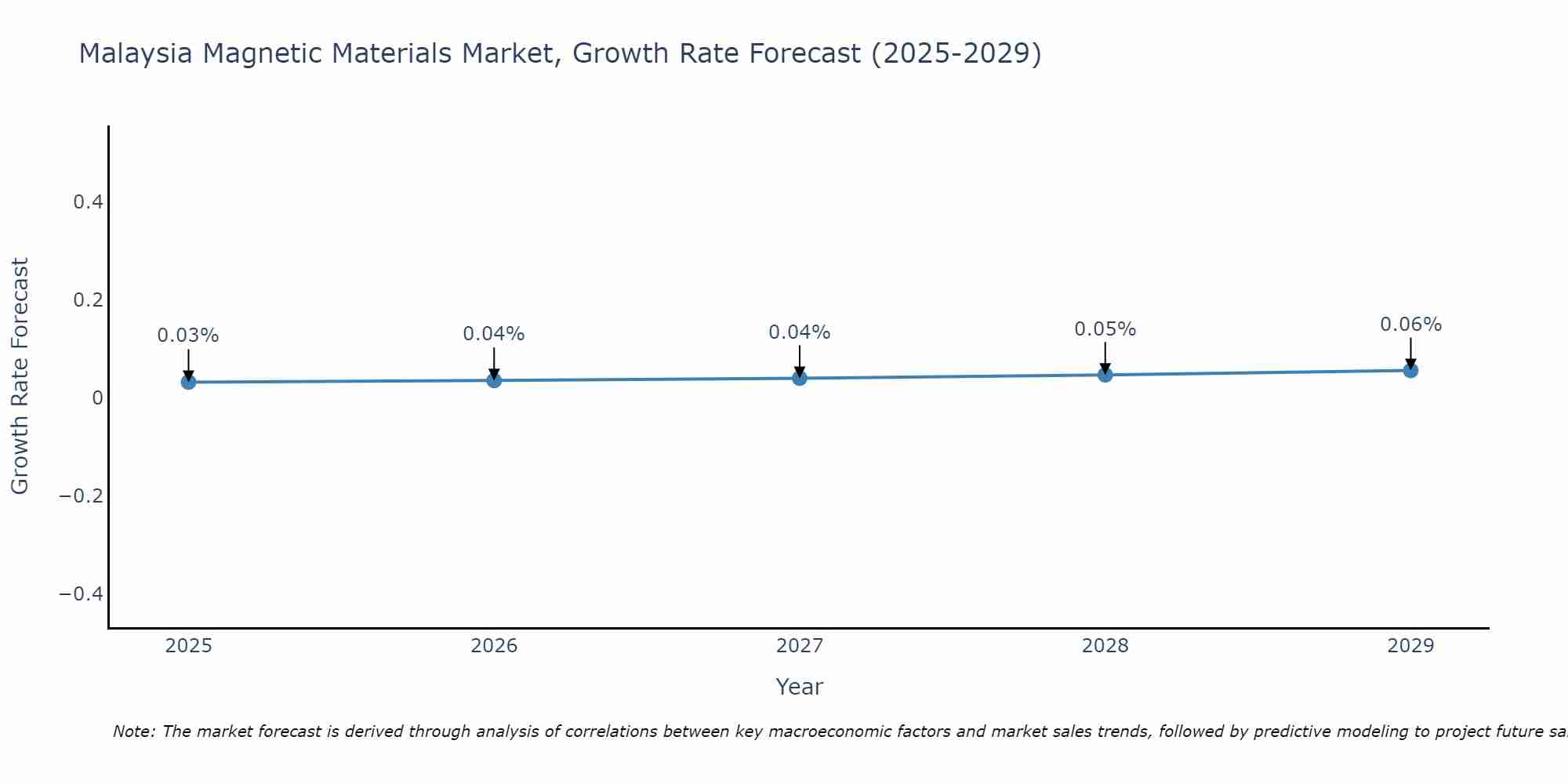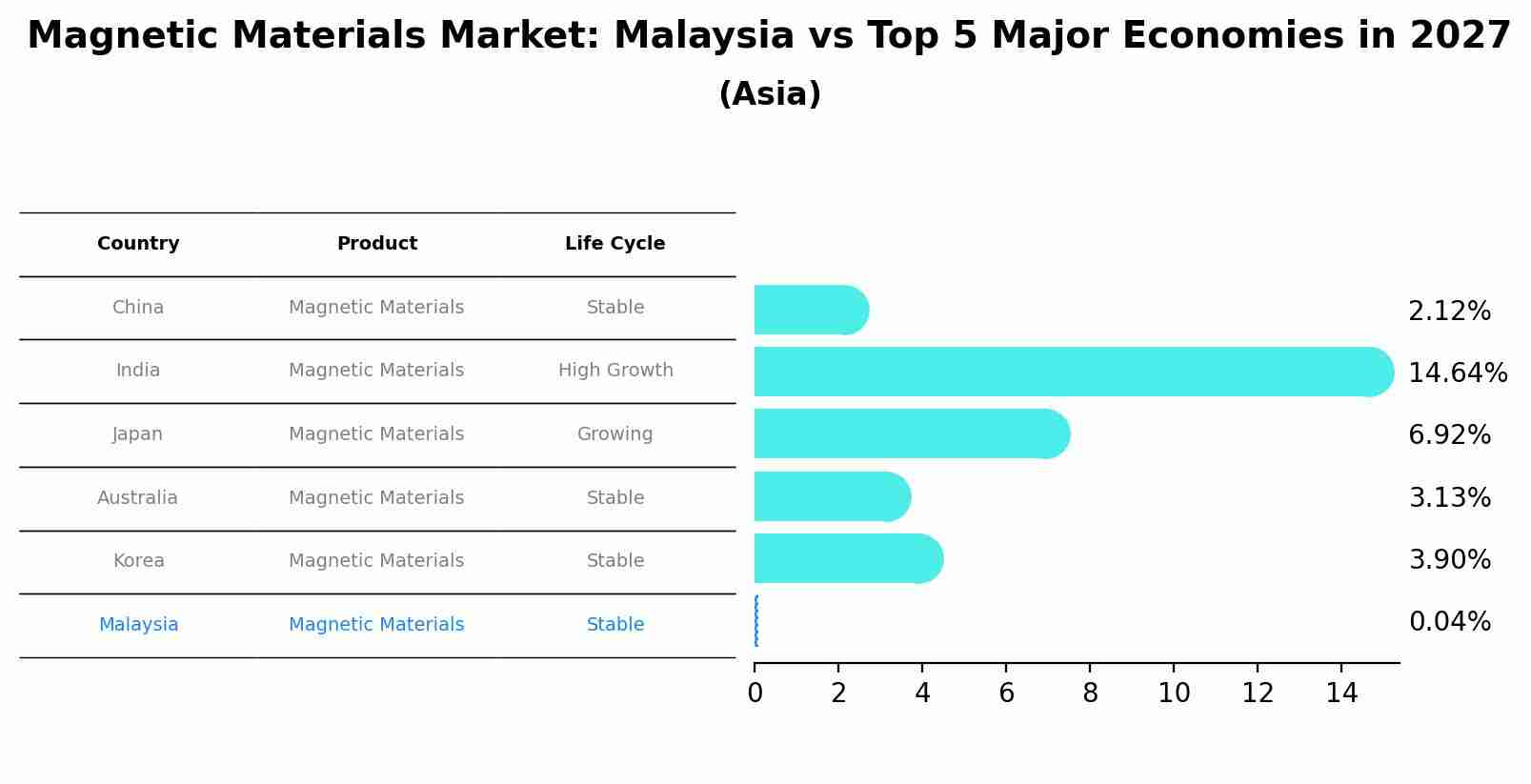Malaysia Magnetic Materials Market (2024-2030) | Value, Size, Growth, Revenue, Industry, Outlook, Forecast, Share, Companies, Trends, Analysis
| Product Code: ETC008986 | Publication Date: Jun 2023 | Updated Date: Apr 2025 | Product Type: Report | |
| Publisher: 6Wresearch | No. of Pages: 70 | No. of Figures: 35 | No. of Tables: 5 | |
Malaysia Magnetic Materials Market Size Growth Rate
The Malaysia Magnetic Materials Market is likely to experience consistent growth rate gains over the period 2025 to 2029. From 0.03% in 2025, the growth rate steadily ascends to 0.06% in 2029.

Magnetic Materials Market: Malaysia vs Top 5 Major Economies in 2027 (Asia)
Malaysia's Magnetic Materials market is anticipated to experience a stable growth rate of 0.04% by 2027, reflecting trends observed in the largest economy China, followed by India, Japan, Australia and South Korea.

Malaysia Magnetic Materials Market Synopsis
The Malaysia Magnetic Materials market is expected to grow at a CAGR of 5.9% during the forecast period (2020-2026). The growth of this market is driven by an increase in demand for technological advancements, such as miniaturization and lighter components in various applications including automotive, aerospace & defense, consumer electronics, energy generation and storage systems among others. Additionally, increasing government initiatives towards renewable energy sources such as wind turbines and solar panels are also projected to drive the magnetic materials industry during the forecast period
Key Highlights of the Report:
- Malaysia Magnetic Materials Market Outlook
- Market Size of Malaysia Magnetic Materials Market, 2023
- Forecast of Malaysia Magnetic Materials Market, 2030
- Historical Data and Forecast of Malaysia Magnetic Materials Revenues & Volume for the Period 2020-2030
- Malaysia Magnetic Materials Market Trend Evolution
- Malaysia Magnetic Materials Market Drivers and Challenges
- Malaysia Magnetic Materials Price Trends
- Malaysia Magnetic Materials Porter's Five Forces
- Malaysia Magnetic Materials Industry Life Cycle
- Historical Data and Forecast of Malaysia Magnetic Materials Market Revenues & Volume By Product Types for the Period 2020-2030
- Historical Data and Forecast of Malaysia Magnetic Materials Market Revenues & Volume By Semi-hard Magnet for the Period 2020-2030
- Historical Data and Forecast of Malaysia Magnetic Materials Market Revenues & Volume By Soft Magnet for the Period 2020-2030
- Historical Data and Forecast of Malaysia Magnetic Materials Market Revenues & Volume By Hard Magnet for the Period 2020-2030
- Historical Data and Forecast of Malaysia Magnetic Materials Market Revenues & Volume By Applications for the Period 2020-2030
- Historical Data and Forecast of Malaysia Magnetic Materials Market Revenues & Volume By Automotive for the Period 2020-2030
- Historical Data and Forecast of Malaysia Magnetic Materials Market Revenues & Volume By Electronics for the Period 2020-2030
- Historical Data and Forecast of Malaysia Magnetic Materials Market Revenues & Volume By Industrial for the Period 2020-2030
- Historical Data and Forecast of Malaysia Magnetic Materials Market Revenues & Volume By Power Generation for the Period 2020-2030
- Historical Data and Forecast of Malaysia Magnetic Materials Market Revenues & Volume By Others for the Period 2020-2030
- Malaysia Magnetic Materials Import Export Trade Statistics
- Market Opportunity Assessment By Product Types
- Market Opportunity Assessment By Applications
- Malaysia Magnetic Materials Top Companies Market Share
- Malaysia Magnetic Materials Competitive Benchmarking By Technical and Operational Parameters
- Malaysia Magnetic Materials Company Profiles
- Malaysia Magnetic Materials Key Strategic Recommendations
Frequently Asked Questions About the Market Study (FAQs):
1 Executive Summary |
2 Introduction |
2.1 Key Highlights of the Report |
2.2 Report Description |
2.3 Market Scope & Segmentation |
2.4 Research Methodology |
2.5 Assumptions |
3 Malaysia Magnetic Materials Market Overview |
3.1 Malaysia Country Macro Economic Indicators |
3.2 Malaysia Magnetic Materials Market Revenues & Volume, 2020 & 2030F |
3.3 Malaysia Magnetic Materials Market - Industry Life Cycle |
3.4 Malaysia Magnetic Materials Market - Porter's Five Forces |
3.5 Malaysia Magnetic Materials Market Revenues & Volume Share, By Product Types, 2020 & 2030F |
3.6 Malaysia Magnetic Materials Market Revenues & Volume Share, By Applications, 2020 & 2030F |
4 Malaysia Magnetic Materials Market Dynamics |
4.1 Impact Analysis |
4.2 Market Drivers |
4.3 Market Restraints |
5 Malaysia Magnetic Materials Market Trends |
6 Malaysia Magnetic Materials Market, By Types |
6.1 Malaysia Magnetic Materials Market, By Product Types |
6.1.1 Overview and Analysis |
6.1.2 Malaysia Magnetic Materials Market Revenues & Volume, By Product Types, 2020-2030F |
6.1.3 Malaysia Magnetic Materials Market Revenues & Volume, By Semi-hard Magnet, 2020-2030F |
6.1.4 Malaysia Magnetic Materials Market Revenues & Volume, By Soft Magnet, 2020-2030F |
6.1.5 Malaysia Magnetic Materials Market Revenues & Volume, By Hard Magnet, 2020-2030F |
6.2 Malaysia Magnetic Materials Market, By Applications |
6.2.1 Overview and Analysis |
6.2.2 Malaysia Magnetic Materials Market Revenues & Volume, By Automotive, 2020-2030F |
6.2.3 Malaysia Magnetic Materials Market Revenues & Volume, By Electronics, 2020-2030F |
6.2.4 Malaysia Magnetic Materials Market Revenues & Volume, By Industrial, 2020-2030F |
6.2.5 Malaysia Magnetic Materials Market Revenues & Volume, By Power Generation, 2020-2030F |
6.2.6 Malaysia Magnetic Materials Market Revenues & Volume, By Others, 2020-2030F |
7 Malaysia Magnetic Materials Market Import-Export Trade Statistics |
7.1 Malaysia Magnetic Materials Market Export to Major Countries |
7.2 Malaysia Magnetic Materials Market Imports from Major Countries |
8 Malaysia Magnetic Materials Market Key Performance Indicators |
9 Malaysia Magnetic Materials Market - Opportunity Assessment |
9.1 Malaysia Magnetic Materials Market Opportunity Assessment, By Product Types, 2020 & 2030F |
9.2 Malaysia Magnetic Materials Market Opportunity Assessment, By Applications, 2020 & 2030F |
10 Malaysia Magnetic Materials Market - Competitive Landscape |
10.1 Malaysia Magnetic Materials Market Revenue Share, By Companies, 2023 |
10.2 Malaysia Magnetic Materials Market Competitive Benchmarking, By Operating and Technical Parameters |
11 Company Profiles |
12 Recommendations |
13 Disclaimer |
- Single User License$ 1,995
- Department License$ 2,400
- Site License$ 3,120
- Global License$ 3,795
Search
Related Reports
- Europe Flooring Market (2025-2031) | Outlook, Share, Industry, Trends, Forecast, Companies, Revenue, Size, Analysis, Growth & Value
- Saudi Arabia Manlift Market (2025-2031) | Outlook, Size, Growth, Trends, Companies, Industry, Revenue, Value, Share, Forecast & Analysis
- Uganda Excavator, Crane, and Wheel Loaders Market (2025-2031) | Strategy, Consumer Insights, Analysis, Investment Trends, Opportunities, Growth, Size, Share, Industry, Revenue, Segments, Value, Segmentation, Supply, Forecast, Restraints, Outlook, Competition, Drivers, Trends, Demand, Pricing Analysis, Competitive, Strategic Insights, Companies, Challenges
- Rwanda Excavator, Crane, and Wheel Loaders Market (2025-2031) | Strategy, Consumer Insights, Analysis, Investment Trends, Opportunities, Growth, Size, Share, Industry, Revenue, Segments, Value, Segmentation, Supply, Forecast, Restraints, Outlook, Competition, Drivers, Trends, Demand, Pricing Analysis, Competitive, Strategic Insights, Companies, Challenges
- Kenya Excavator, Crane, and Wheel Loaders Market (2025-2031) | Strategy, Consumer Insights, Analysis, Investment Trends, Opportunities, Growth, Size, Share, Industry, Revenue, Segments, Value, Segmentation, Supply, Forecast, Restraints, Outlook, Competition, Drivers, Trends, Demand, Pricing Analysis, Competitive, Strategic Insights, Companies, Challenges
- Angola Excavator, Crane, and Wheel Loaders Market (2025-2031) | Strategy, Consumer Insights, Analysis, Investment Trends, Opportunities, Growth, Size, Share, Industry, Revenue, Segments, Value, Segmentation, Supply, Forecast, Restraints, Outlook, Competition, Drivers, Trends, Demand, Pricing Analysis, Competitive, Strategic Insights, Companies, Challenges
- Israel Intelligent Transport System Market (2025-2031) | Strategy, Consumer Insights, Analysis, Investment Trends, Opportunities, Growth, Size, Share, Industry, Revenue, Segments, Value, Segmentation, Supply, Forecast, Restraints, Outlook, Competition, Drivers, Trends, Demand, Pricing Analysis, Competitive, Strategic Insights, Companies, Challenges
- Uganda Precast and Aggregate Market (2025-2031) | Strategy, Consumer Insights, Analysis, Investment Trends, Opportunities, Growth, Size, Share, Industry, Revenue, Segments, Value, Segmentation, Supply, Forecast, Restraints, Outlook, Competition, Drivers, Trends, Demand, Pricing Analysis, Competitive, Strategic Insights, Companies, Challenges
- Australia IT Asset Disposal Market (2025-2031) | Strategy, Consumer Insights, Analysis, Investment Trends, Opportunities, Growth, Size, Share, Industry, Revenue, Segments, Value, Segmentation, Supply, Forecast, Restraints, Outlook, Competition, Drivers, Trends, Demand, Pricing Analysis, Competitive, Strategic Insights, Companies, Challenges
- UAE Building Thermal Insulation Market Outlook (2025-2031) | Revenue, Companies, Share, Trends, Growth, Size, Forecast, Industry, Analysis & Value
Industry Events and Analyst Meet
Our Clients
Whitepaper
- Middle East & Africa Commercial Security Market Click here to view more.
- Middle East & Africa Fire Safety Systems & Equipment Market Click here to view more.
- GCC Drone Market Click here to view more.
- Middle East Lighting Fixture Market Click here to view more.
- GCC Physical & Perimeter Security Market Click here to view more.
6WResearch In News
- Doha a strategic location for EV manufacturing hub: IPA Qatar
- Demand for luxury TVs surging in the GCC, says Samsung
- Empowering Growth: The Thriving Journey of Bangladesh’s Cable Industry
- Demand for luxury TVs surging in the GCC, says Samsung
- Video call with a traditional healer? Once unthinkable, it’s now common in South Africa
- Intelligent Buildings To Smooth GCC’s Path To Net Zero













